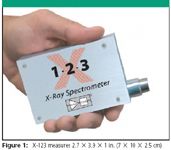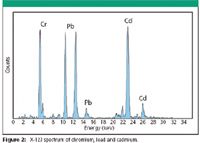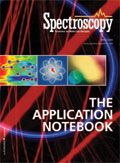RoHS/WEEE Application of a Miniature X-Ray Spectrometer
Application Notebook
The RoHS/WEEE directive requires the electronics industry to certify that products comply with maximum concentration amounts of particular elements and compounds (Cr VI, Pb, Cd, Hg, Br PBB/PBDE) by July 2006. Instrumentation must be developed to perform the certification.
The RoHS/WEEE directive requires the electronics industry to certify that products comply with maximum concentration amounts of particular elements and compounds (Cr VI, Pb, Cd, Hg, Br PBB/PBDE) by July 2006. Instrumentation must be developed to perform the certification.

Figure 1: X-123 measures 2.7 x 3.9 x 1 in. (7 x 10 x 2.5 cm)
Solution
Provide OEMs and end users with a powerful X-ray spectrometer system in one convenient, small, easy to use instrument that can be quickly implemented to minimize time to market. No additional engineering is required on the spectrometer end since all the connections have been made internally. All that is needed is a +5 Volts DC input power and a USB or RS232 connection to a computer.

Figure 2: X-123 spectrum of chromium, lead and cadmium.
The X-123 represents the culmination of 14 years of Xray detector development at Amptek. Our philosophy has always been to create small, low power, high performance instruments while keeping them simple to operate. The X-123 exemplifies this philosophy by providing in a single package the XR-100CR X-Ray Detector and Charge Sensitive Preamplifier, and the DP4 Digital Pulse Processor. The internal PC4-3 Power Supply provides all the necessary voltages for the entire system.
The XR-100CR is a high performance X-ray detector using a thermoelectrically cooled Si-PIN photodiode as an X-ray detector. Also mounted on the 2-stage cooler are the input FET and a novel feedback circuit. These components are kept at approximately –55 °C, and are monitored by an internal temperature sensor. The cooling is completely transparent to the user. The hermetic TO-8 package of the detector has a light tight, vacuum tight thin Beryllium window to enable soft X-ray detection.
The DP4 is a state-of-the-art, high performance, low power digital pulse processor. It digitizes the preamplifier output signals, replacing both the shaping amplifier and MCA in a traditional, analog system. The DP4 offers several advantages over analog systems, including improved performance (high resolution, higher throughput, and enhanced stability), flexibility, low power consumption, small size, and low cost. It includes an 8051 compatible microcontroller for controlling the unit and is supplied with all necessary software and firmware (including source code to facilitate customization by the user).
The X-123 does not sacrifice performance for size. The resolution for the 5.9 keV peak of 55 Fe is 145 eV FWHM to 260 eV FWHM depending on detector type and shaping time constant. Since the X-123 is a complete packaged spectrometer, it is the perfect choice for fast-track product development and will provide the OEM with the quickest time to market.
Amptek, Inc.14 Deangelo Drive Bedford, MA 01730 Tel. (781) 275-2242, Fax. (781) 275-3470 sales@amptek.comwww.amptek.com
